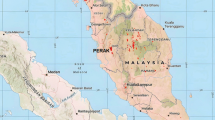Abstract
Formulation of different ecological zone plans according to the corresponding protection targets and the necessity of proper conservation policy is one of the measures to achieve the goal of ecological conservation in China. In order to clarify the interrelation among key ecological zone plans, this paper carried out the research on spatial relation of priority areas of biodiversity conservation and three key ecological areas (key ecological function areas, key regions of ecological service function, national nature reserves) and the research on ecological conditions, based on multi-scale ecological spatial theme information, which incorporates elements like ecological quality and type, and by the aid of spatial information analysis and GIS modeling. The results showed a contrastively fine spatial consistency with 68.8% of priority areas of biodiversity conservation overlapping with three key ecological areas. Although the environment in priority areas of biodiversity conservation were in good conditions, protection pressure is also increasing, powerful supervision and protection should not be ignored. The environmental conditions in the overlapping areas, as a whole, were superior to those in the non-overlapping areas. Since two areas have different characteristics, targeted protection measures should be formulated based on this difference, which will be very important for biodiversity conservation in priority areas of biodiversity conservation.
Similar content being viewed by others
References
Adenle A A, 2012. Failure to achieve 2010 biodiversity’s target in developing countries: How can conservation help. Biodiversity and Conservation, 21(10): 2435–2442. doi: 10.1007/s10531-012-0325-z
Bai Y, Zhuang C, Ouyang Z, 2011. Spatial characteristics be tween biodiversity and ecosystem services in a human-dominated watershed. Ecological Complexity, 8(2): 177–183. doi: 10.1016/j.ecocom.2011.01.007
Bene C, Do L, 2008. Contribution values of biodiversity to ecosystem performances: A viability perspective. Ecological Economics, 68(2): 14–23. doi: 10.1016/j.ecolecon.2008.08.015
Boutin S, Highland D L, Schieck J, 2009. A new approach to forest biodiversity monitoring in Canada. Forest Ecology and Management, 258(3): S168–S175. doi: 10.1016/j.foreco.2009.08.024
Cai Jialiang, Yin He, Huang Yi, 2010. Ecological function regionalization: A review. Acta Ecologica Sinica, 30(11): 3018–3027. (in Chinese)
David E G, 2003. Biodiversity Impact Assessment of roads: An approach based on ecosystem rarity. Environmental Impact Assessment Review, 23(3): 343–365. doi: 10.1016/S0195-9255(02)00099-9
Ding Sibao, 2009. Some basic theoretical issues faced with plan of essential function region system. Scientia Geographica Sinica, 29(4): 587–592. (in Chinese)
Fisher B, Christopher T, 2007. Poverty and biodiversity: Measuring the overlap of human poverty and the biodiversity hotspots. Ecological Economics, 62(3): 93–101. doi: 10.1016/j.ecolecon.2006.05.020
Jiang Dong, Yang Xiaohuan, Luo Chun, 2004. Relation analysis of population distribution and topographic features based on km grid. Symposium of Environmental Remote Sensing Science Annual Meeting, 148–153. (in Chinese)
Laura M, 2012. Building shared socio-economic indicators for biodiversity: A case study in the Ile-de-France region (France). Ecological Indicators, 13(3): 347–357. doi: 10.1016/j.ecolind.2011.05.015
Lawrence A, Turnhout E, 2010. Personal meaning in the public sphere: The standardization and rationalization of biodiversity data in the UK and the Netherlands. Journal of Rural Studies, 26(3): 353–360. doi: 10.1016/j.jrurstud.2010.02.001
Li Y, Nigh T, 2011. GIS-based prioritization of private land parcels for biodiversity conservation: A case study from the Current and Eleven Point Conservation Opportunity Areas, Missouri. Applied Geography, 31(3): 98–107. doi: 10.1016/j. apgeog.2010.02.006
Liu J L, Li F R, Liu C A et al., 2012. Influences of shrub vegetation on distribution and diversity of a ground beetle community in a Gobi desert ecosystem. Biodiversity and Conservation, 21(10): 2601–2619. doi: 10.1007/s10531-012-0320-4
Ministry of Environmental Protection of People’ Republic of China, 2011. China Biodiversity Conservation Strategy and Action Plan (2011–2030). Beijing: China Environmental Science Press. (in Chinese)
Ministry of Environmental Protection of the People’ Republic of China, 2009. China Environmental Quality Report. Beijing: China Environmental Science Press. (in Chinese)
Ren Hongyuan, 2007. The relationship between main function regionalization and ecological function regionalization. Tianjin Economy, 14(8): 46–49. (in Chinese)
Roy H Y, 2009. Land use and biodiversity relationships. Land Use Policy, 26(1): S178–S186. doi: 10.1016/j.landusepol.2009.08.009
Schneiders A, Daele T V, Landuyt W V et al., 2012. Biodiversity and ecosystem services: Complementary approaches for ecosystem management. Ecological Indicators, 17(3): 123–133. doi: 10.1016/j.ecolind.2011.06.021
Swift M J, Izaca M N, Noordwijk V M, 2004. Biodiversity and ecosystem services in agricultural landscapes-are we asking the right questions. Agriculture, Ecosystems & Environment, 104(1): 113–134. doi: 10.1016/j.agee.2004.01.013
The Group of’ The Research of the Relationship between Main Function Regionalization and Ecological Function Regionalization’, 2007. It must be sure that the relationship between main function regionalization and ecological function regionalization. Zhejiang Economic, 29(2): 36–39. (in Chinese)
Wei Haiyan, Wang Li, Fang Jiao, 2010. Researches on the quantitative relationship between urbanization level and ecological environment stress: Take Xi’an as an Example. Areal Research and Development, 29(5): 94–98. (in Chinese)
Yan Nailing, Yu Xiaogan, 2003. Objective, principle and system of ecological function zoning in China. Resources and Environment in the Yangtze Basin, 12(6): 579–585. (in Chinese)
Author information
Authors and Affiliations
Corresponding author
Additional information
Foundation item: Under the auspices of Public Science and Technology Research Funds of Environment (No. 201009021, 2011467026, 2012467044), National Key Technology R&D Program of China (No. 2012BAH32B03), National Natural Science Foundation of China (No. 41171318, 41001160)
Rights and permissions
About this article
Cite this article
Wang, W., Zheng, H., Xu, C. et al. Spatial correlation and ecological characteristics analysis of management area for biodiversity conservation and relevant regionalization. Chin. Geogr. Sci. 24, 71–82 (2014). https://doi.org/10.1007/s11769-014-0657-6
Received:
Accepted:
Published:
Issue Date:
DOI: https://doi.org/10.1007/s11769-014-0657-6




